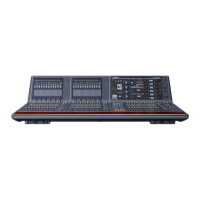Monitor
31 RIVAGE PM10 Operation Manual
Two sets of monitor output are provided, MONITOR A and MONITOR B, and you can
independently select the monitor source and adjust the output level for each.
Number of systems
There are two sets of monitor output, MONITOR A and MONITOR B.
1 Headphone output
Two headphone outputs are provided, PHONES A and PHONES B.
2 Input selector
You can provide eight sources to be monitored, and switch between them. The signals of up to
eight channels can be assigned to one monitor source. You can select not only channel or bus
signals, but signals directly from input patches as monitor signals.
3 Monitor circuit structure
This consists of three channels: L-channel, R-channel, and CENTER channel.
4 DELAY
Allows the monitor signal to be delayed. You can specify up to 1000 msec. You can select the
delay time unit from the following: meter, feet, sample, msec, frame, depending on your
application.
5 INSERT
A plug-in, GEQ, or PEQ can be inserted. The insert point is fixed at PRE EQ (immediately
before the EQ). An insert point is also provided for the PHONES OUT.
6 PEQ
The monitor section provides an 8-band parametric EQ specialized for monitoring.
7 MONITOR LEVEL
The MONITOR OUT L-channel, R-channel, and CENTER channel output levels can be
adjusted. The monitor level can also be assigned to a fader.
8 Output structure
• L-channel, R-channel, and CENTER channel of MONITOR A
• L-channel, R-channel, and CENTER channel of MONITOR B
9 CUE SOLO LOGIC
Causes the CUE signal to interrupt the monitor output when CUE is active. The CENTER
channel can be turned on/off independently.
) DIMMER ON TALKBACK
Attenuates the monitor signal by a fixed amount.
! PHONES LEVEL LINK
The level of the signal sent to the PHONES A/PHONES B jacks is linked with the MONITOR A/
MONITOR B LEVEL.
@ MONITOR OUT MODE
Downmixes the L/R signals to monaural.
This also downmixes the L/R/C signals to L/R.
# L R+C DOWNMIX
Allows you to downmix the L/R/C signals to L/R.
$ DIMMER ON CUE
When the CUE signal has interrupted the monitor output, this attenuates the signal that is being
input to the monitor.
NOTE
Monitor assignments and on/off switching can also be assigned to a USER DEFINED key.
Monitor
MONITOR
SOURCE
SELECT
STEREO
OSC
MIX
MATRIX
TALKBACK
INPUT CH
(DIRECT OUT)
CUE TRIM
L
R
C
DELAY
DIMMER
ON CUE
MONITOR
OUT
MODE
CUE OUT
MODE
MONITOR
PEQ
CUE PEQ
CUE SOLO LOGIC
LEVEL
PRE EQ
(CUE)
PRE DELAY
(CUE)
POST DELAY
(CUE)
LEVEL
CUE OUT
MONITOR A OUT
L
R
L
R
C
PHONES A-B
[PHONES OUT A, B]
DA
PHONES
LEVEL
Tip
Ring
Sleeve
POST EQ
(CUE)
PRE DELAY
(MONITOR)
CUE
PRE DELAY
POST DELAY
MONITOR
PRE DELAY
POST DELAY
DIMMER/
DIMMER
ON
TALKBACK
DIMMER
ON
TALKBACK
L R+C
DOWN-
MIX
PHONES
LEVEL LINK
PHONES
LEVEL
LINK
INSERT
INSERT
PLUG-IN
INSERT
POST DELAY
(MONITOR)
CUE/SOLO
LOGIC
L
R
C
CUE
A/B
LR
5
5
2
1
3
6@$ )
# !
7
)
4
8
9

